|
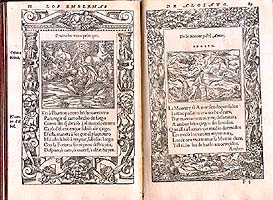
pages 88-89 of Alciati
Los emblemas traducidos en rhimas
Españolas
(S.M. 32a) |
Andrea Alciati Los emblemas traducidos en rhimas
Españolas
Lyon: Guillaume Rouille, 1549
Stirling Maxwell S.M. 32a
The first Spanish version of Andrea Alciati's
Emblemata (1531), the progenitor of the emblem genre. The
translator was Bernardino Daza, a native of Valladolid and brother of
the famous surgeon Dionisio Daza Chacón, who is mentioned by Cervantes
in the 'Canto de Caliope' of La Galatea. Bernardino received his
'bachillerato' in 1547, became a 'licenciado en leyes' in 1555 and was
awarded the doctorate in 1566. In 1576 he is known to have been a
professor of law at the University of Valladolid. Besides this work,
he wrote a treatise on, and translated the Justinian code.
Daza's translation of the Emblemata is not a
literal one. He preferred to accompany the emblems with verses of a
variety of forms to interpret their general meaning and intent; two of
the emblems are his own inventions.
The signature of Raphael Abenyacar on the last leaf
indicates an early Sephardic ownership.
|
|
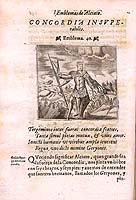
folio 136v from Alciati
Declaracíon magistral sobre las
emblemas
(S.M. 1225) |
Andrea Alciati Declaracíon magistral sobre las
emblemas
Najera: Juan de Mongaston, 1615
Stirling Maxwell S.M. 1225
This edition of Alciati's Emblemata contains
the Latin mottoes and stanzas followed by a Spanish commentary. The
commentator, Diego López, was a native of Valencia de Alcántara, and
teacher and preceptor of grammar and Latin, which he taught in Toro and
Olmedo in the years 1611 and 1620. Friend of Diego Hurtado de Mendoza,
to whom this first edition of the Declaracíon is dedicated, he
also translated, and wrote a commentary on, the works of Virgil,
Juvenal, Aulus Persius Flaccus, and Valerius Flaccus. There were
at least three other editions of the Declaracíon, in 1655, 1670,
and 1684; copies of the latter two are in Glasgow University Library.
This copy has the signature of Diego López on the
verso of the second leaf, partly obliterated.
|
|
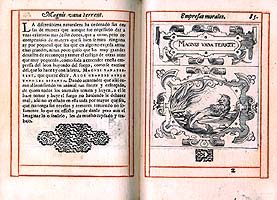
folios 84v-85r: Borja Empresas morales (S.M. 204) |
Juan de Borja Empresas morales
Prague: Jorge Nigrin, 1581
Stirling Maxwell S.M. 204
Don Juan de Borja, Conde de Mayalde y de
Ficallo, was Ambassador to Portugal (for Philip II) and to the
Emperor Rudolph II, Lord High Steward to the Empress Maria and to
Queen Margarita, and a member of the Councils of State and War of
Philip III.
Although issued in Prague by one of that city's
most prolific printers, Jiři Čérný, this is the
first Spanish emblem book to be written by a native. It contains
one hundred copperplate engravings of emblems in richly decorated
frames, many signed 'E.I.' A much enlarged edition, with two
hundred and twenty-four emblems, was published by Boria's
descendant, Francisco de Boria, at Brussels in 1680, a Latin
translation by Ludovicus Camerarius appeared at Berlin in 1697 and
a German translation by Georg Friedrich Scharff was published at
Berlin in 1693. Copies of all these editions are in Glasgow
University Library.
On the fly-leaf of this copy Sir William Stirling Maxwell notes:
'Of this rare first edition of the Empresas Morales of Don
Juan de Borja, 1581, I have never seen another copy. I bought it
at Madrid in 1864.'
|
Juan de Horozco y Covarrubias Emblemas morales
Segovia: Juan de la Cuesta, 1589
Stirling Maxwell S.M. Add 208
Juan de Horozco y Covarrubias (or Covarrubias y
Orozco, 1550-1608?) was a canon of Seville and Bishop of Agrigento in
Sicily. He was a native of Toledo, and a nephew of Don Diego Covarrubias
y Leiva, the eminent Spanish theologian, to whom this book is
dedicated.
This is the first emblem book to be published in
Spain. Other editions followed in 1591, 1691 and 1604: a Latin
translation was published at Agrigento in 160l. The Library possesses
copies of all of these. The work is divided into three books.
Book 1 consists of a dissertation on emblems, devices, hieroglyphics,
etc. Books 2 and 3 each contain fifty emblems; the verses for each
emblem are followed by a lengthy prose commentary.
|
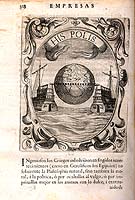
page 368 from Fajardo
Idea de un principe politico Chiristiano
(S.M. 1464) |
Diego de Saavedra Fajardo Idea de un principe
politico Chiristiano. Representada en cien empresas
Monaco [Munich]: en la emprenta de Nicolao Enrico, 1640
Stirling Maxwell S.M. 1464
The first edition of the most famous of political
emblem books. In it the author gives his description of an ideal
Christian ruler; his education, characteristics, and manner of dealing
with his subjects, foreigners, governments, political crises at home and
abroad; his victories and peace treaties, and how he should act in his
old age. The work was intended to combat the doctrines of Machiavelli as
expressed in his Prince.
Saavedra Fajardo (1534-1648) was a native of Murcia,
and studied law at Salamanca. He became a knight of Santiago at the age
of twenty-two; secretary to Cardinal de Borja, Spanish Ambassador at
Rome; and Minister at the Court of Bavaria. He represented Spain at the
Munster congress in 1643, and became a member of the Council for the
Indies in Madrid in 1646.
|
|
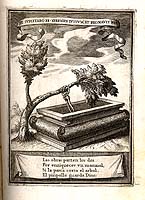
plate from Monforte
Descripcion de las
honras que se hicieron a Phelippe quarto
(S.M. 1455) |
Pedro Rodriguez de Monforte Descripcion de las
honras que se hicieron a Phelippe quarto
Madrid: Francisco Nieto, 1666
Stirling Maxwell S.M. 1455
The funeral ceremonies for Philip IV of Spain held in Madrid,
September 1665 were directed by Baltasar Barroso de Ribera by order of
the Queen. The King's body was dressed in a musk-coloured velvet suit,
embroidered with silver, with a silver sword by his side and a diamond
cross in his hands. It was enclosed in silver and red velvet coffins and
placed high upon a dais under a canopy illuminated by great wax torches, surrounded with the insignia of
imperial majesty and guarded by the halberdiers of Espinosa. Seven
altars and scores of lighted tapers were erected in the chamber, and
masses for the King's soul were ceaselessly offered. But when the time
came for the burial in the Escorial few of the high nobles and
officers cared to absent themselves from Madrid and even the bearing of
the body to the mule litter gave rise to a hot dispute.
The book contains a number of fine engravings by
Pedro de Villafranca Malagon, the most notable being that of the
catafalque and a portrait of Philip surrounded by suitable symbols and
allegorical figures.
|
|